My code creates a graph and creates a pivot point on each node, if you double click them it'll fetch more data associated with that node and hopefully creates new links. Now here's the problem I'm running into:
I clicked on one of the outermost nodes but for some reason the new links were being attached to the first node (the blue one). Any idea why this is happening?
function draw_graph(graph) {
var color = d3.scaleOrdinal(d3.schemeCategory20);
var svg = d3.select("svg"),
width = +svg.attr("width"),
height = +svg.attr("height"),
node,
link;
svg.append('defs').append('marker')
.attrs({
'id': 'arrowhead',
'viewBox': '-0 -5 10 10',
'refX': 13,
'refY': 0,
'orient': 'auto',
'markerWidth': 13,
'markerHeight': 13,
'xoverflow': 'visible'
})
.append('svg:path')
.attr('d', 'M 0,-5 L 10 ,0 L 0,5')
.attr('fill', '#999')
.style('stroke', 'none');
var simulation = d3.forceSimulation()
.force("link", d3.forceLink().id(function (d) {
return d.id;
}).distance(200).strength(1))
.force("charge", d3.forceManyBody())
.force("center", d3.forceCenter(width / 2, height / 2));
update(graph.links, graph.nodes);
svg.selectAll('circle').on('dblclick', function () {
var pivot_id = ($(this).siblings('title').text())
console.log('pivoting on', pivot_id)
pivot_search(pivot_id)
});
function update(links, nodes) {
link = svg.selectAll(".link")
.data(links)
.enter()
.append("line")
.attr("class", "link")
.attr('marker-end', 'url(#arrowhead)')
edgepaths = svg.selectAll(".edgepath")
.data(links)
.enter()
.append('path')
.attrs({
'class': 'edgepath',
'fill-opacity': 0,
'stroke-opacity': 0,
'id': function (d, i) {
return 'edgepath' + i
}
})
.style("pointer-events", "none");
edgelabels = svg.selectAll(".edgelabel")
.data(links)
.enter()
.append('text')
.style("pointer-events", "none")
.attrs({
'class': 'edgelabel',
'id': function (d, i) {
return 'edgelabel' + i
},
'font-size': 10,
'fill': '#aaa'
});
node = svg.selectAll(".node")
.data(nodes)
.enter()
.append("g")
.attr("class", "node")
.call(d3.drag()
.on("start", dragstarted)
.on("drag", dragged)
);
node.append("circle")
.attr("r", 5)
.attr("fill", function (d) {
return color(d.group);
})
node.append("title")
.text(function (d) {
return d.id;
});
node.append("text")
.attr("dy", -3)
.text(function (d) {
return d.label;
});
simulation
.nodes(nodes)
.on("tick", ticked);
simulation.force("link")
.links(links);
}
function ticked() {
link
.attr("x1", function (d) {
return d.source.x;
})
.attr("y1", function (d) {
return d.source.y;
})
.attr("x2", function (d) {
return d.target.x;
})
.attr("y2", function (d) {
return d.target.y;
});
node
.attr("transform", function (d) {
return "translate(" + d.x + ", " + d.y + ")";
});
edgepaths.attr('d', function (d) {
return 'M ' + d.source.x + ' ' + d.source.y + ' L ' + d.target.x + ' ' + d.target.y;
});
edgelabels.attr('transform', function (d) {
if (d.target.x < d.source.x) {
var bbox = this.getBBox();
rx = bbox.x + bbox.width / 2;
ry = bbox.y + bbox.height / 2;
return 'rotate(180 ' + rx + ' ' + ry + ')';
}
else {
return 'rotate(0)';
}
});
}
function dragstarted(d) {
if (!d3.event.active) simulation.alphaTarget(0.3).restart()
d.fx = d.x;
d.fy = d.y;
}
function dragged(d) {
d.fx = d3.event.x;
d.fy = d3.event.y;
}
}
function pivot_search(entity_id) {
var json = {
'nodes': [],
'links': [],
}
get_entities({'id': entity_id})
.done(function (data) {
json.nodes.push({
'label': data['results'][0]['label'],
'id': data['results'][0]['id'],
'group': data['results'][0]['entity_type'],
})
get_entities({
'related_entities': entity_id,
'related_entities__entity_instance__entity_type__strong_entity': true,
'page_size': 500
})
.done(function (data) {
for (var i = 0; i < data['results'].length; i++) {
json.nodes.push({
'label': data['results'][i]['label'],
'id': data['results'][i]['id'],
'group': data['results'][i]['entity_type'],
})
json.links.push({
'source': entity_id,
'target': data['results'][i]['id'],
})
}
draw_graph(json)
})
})
}
EDIT: Upon further investigations seems like it's replacing the existing node links with the new data and creating new potentially duplicate nodes.
link = svg.selectAll('.link')
.data(links, function (d) {
return d.id;
})
.enter()
.append('line')
.attr('class', 'link')
.attr('marker-end', 'url(#arrowhead)')
edgepaths = svg.selectAll('.edgepath')
.data(links)
.enter()
.append('path')
.attrs({
'class': 'edgepath',
'fill-opacity': 0,
'stroke-opacity': 0,
'id': function (d, i) {
return 'edgepath' + i
}
})
.style('pointer-events', 'none');
node = svg.selectAll('.node')
.data(nodes, function (d) {
return d.id;
})
.enter()
.append('g')
.attr('class', 'node')
.call(d3.drag()
.on('start', dragstarted)
.on('drag', dragged)
);
I added an ID to help deal with node duplication, but now I have a problem with index root displacement.



